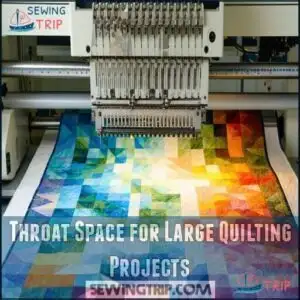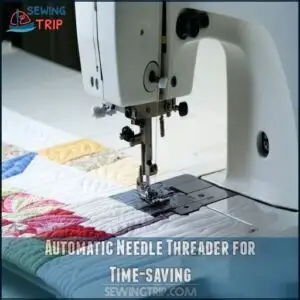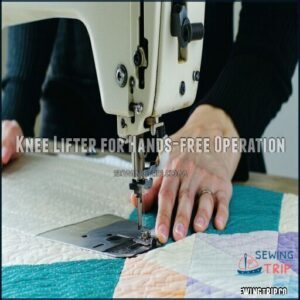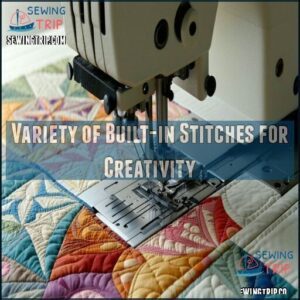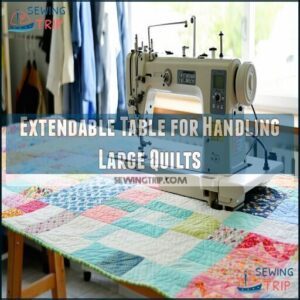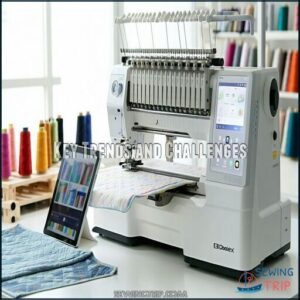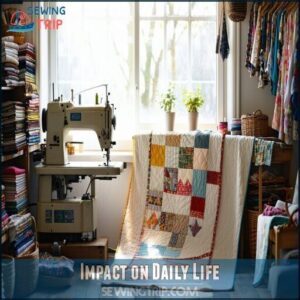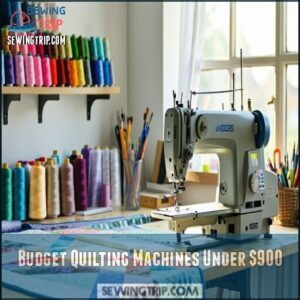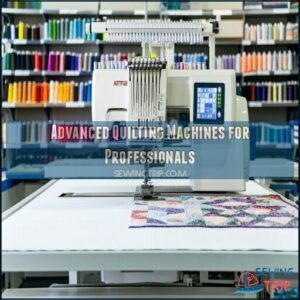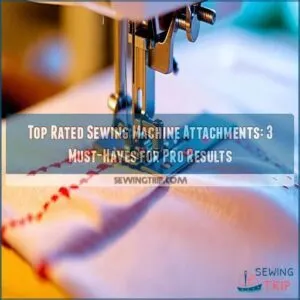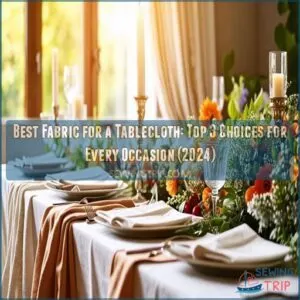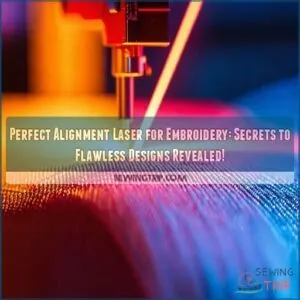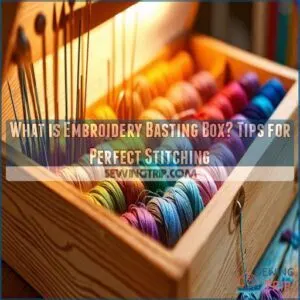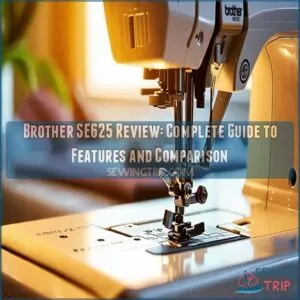This site is supported by our readers. We may earn a commission, at no cost to you, if you purchase through links.
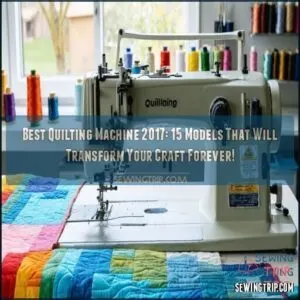 If you’re after the best quilting machine of 2017, the Juki TL-2000Qi stands out for its industrial-grade power and buttery-smooth stitching—perfect for intricate quilting projects.
If you’re after the best quilting machine of 2017, the Juki TL-2000Qi stands out for its industrial-grade power and buttery-smooth stitching—perfect for intricate quilting projects.
Need versatility? The Brother CS6000i offers 60 built-in stitches and an extendable table, making it a dream for both beginners and seasoned quilters.
For tech lovers, the Janome MC6650 combines a wide throat space with computerized precision. And if you’re budget-conscious, the Brother XR3774 delivers solid performance without breaking the bank.
Whether you’re piecing heirloom quilts or tackling large projects, these machines make quilting feel less like work and more like an art form.
Table Of Contents
- Key Features of Top Quilting Machines
- Choosing The Right Quilting Machine
- 15 Best Quilting Machines of 2017
- 1. Singer Start 1304 Sewing Machine
- 2. Juki HZL F600 Sewing Quilting Machine
- 3. Brother PQ1600S Sewing Quilting Machine
- 4. SINGER 9960 Sewing Quilting Machine
- 5. Brother XR3774 Sewing and Quilting Machine
- 6. Brother HC1850 Sewing Quilting Machine
- 7. Juki TL 2000Qi Sewing Quilting Machine
- 8. Janome MC6650 Sewing Quilting Machine
- 9. Janome Magnolia 7318 Sewing Machine Bundle
- 10. Janome DC1050 Computerized Sewing Machine
- 11. Janome 2212 Sewing Machine Bonus Bundle
- 12. Brother XR9500PRW Sewing Machine Project Runway
- 13. Brother SE400 Sewing Embroidery Machine
- 14. Brother CS6000i Sewing Quilting Machine
- 15. Brother PQ1500SL Sewing Quilting Machine
- Budget Quilting Machines Under $900
- Advanced Quilting Machines for Professionals
- Frequently Asked Questions (FAQs)
- Conclusion
Key Features of Top Quilting Machines
You’ll need to focus on throat space, automatic threading, and built-in stitch variety when shopping for your dream quilting machine in 2017.
A generous extension table and knee-lifter function will save your sanity when wrestling with those king-sized family heirloom projects.
Throat Space for Large Quilting Projects
The generous throat of a quilting machine acts like a quilter’s secret weapon when tackling larger projects.
You’ll need adequate space to maneuver those king-sized family heirlooms without frustration.
- 8-11 inches: Minimum throat space for comfortable queen-sized quilt handling
- 12-15 inches: Ideal for most serious quilters’ projects
- 16-20 inches: Professional-grade workspace ergonomics
- 20+ inches: Long arm quilting machine territory for maximum maneuverability
Hoop style affects stitch consistency across varying quilt sizes
Automatic Needle Threader for Time-saving
Threading your needle becomes effortless with an automatic needle threader, saving you precious minutes and reducing eye strain substantially.
This beginner-friendly feature guarantees threading consistency every time, allowing you to focus on your quilting instead of squinting at tiny needle eyes.
The best quilting machine 2017 models prioritize this timesaving innovation, making speed quilting more accessible—especially important when you’re working on multiple projects or quilting during evening hours.
Knee Lifter for Hands-free Operation
Now that you’ve mastered quick threading, let’s talk about the knee lifter – your new quilting best friend.
This hands-free feature lets you raise and lower the presser foot using your knee, keeping both hands on your fabric for precise control during freemotion stitching.
Top quilting machines in 2017 offer smooth knee lifter operation, saving your back and wrists while improving stitch quality.
It’s like having an extra set of hands! This allows for hands-free presser control, which is a significant advantage.
Variety of Built-in Stitches for Creativity
A top quilting machine’s built-in stitch variety transforms your creative potential.
You’ll discover endless design possibilities with specialized quilting stitches for precise piecing and decorative stitches for embellishments.
Modern machines offer hundreds of pattern creation options through stitch combinations that can be fully customized.
Whether you’re creating traditional quilt patterns or innovative designs, these built-in stitches help elevate your quilting projects from ordinary to extraordinary with endless design possibilities.
Extendable Table for Handling Large Quilts
You’ll struggle with large quilting projects without adequate workspace.
An extension table gives your quilting machine the extra sewing surface needed when handling bulky quilts.
Size matters here—look for tables that extend at least 12-18 inches beyond your machine.
The best options offer table stability while providing ergonomic benefits by keeping fabric level, reducing shoulder strain.
Some machines come with built-in extensions, while others accept aftermarket or DIY tables.
Choosing The Right Quilting Machine
You’ll need to examine key features like throat space, stitch options, and tension control when selecting your perfect quilting companion for those fabric masterpieces you’ve been planning.
From computerized wonders with automatic threading to sturdy workhorses with extension tables, the right machine will transform your quilting experience from frustrating fabric fights to smooth sailing through even the thickest layers.
This transformation will make a significant difference, as it changes your experience from frustrating fabric fights to a more enjoyable and efficient process.
Key Trends And Challenges
While you navigate the quilting landscape in 2023, you’ll notice significant automation advancements transforming traditional machines.
Material innovations now allow for smoother handling of complex fabrics, while ergonomic design improvements reduce strain during long projects.
However, you’re likely facing challenges like growing sustainability concerns about textile waste and widening skill gaps as quilting machine technology becomes more sophisticated.
Leading quilting machine brands continue addressing these issues through intuitive interfaces and thorough video tutorials in their latest models, which can help mitigate the skill gaps.
Impact On Daily Life
While trends matter, your quilting machine directly shapes your daily routine.
You’ll find your Time Management improves as automated features cut your project time in half. Many quilters report their quilting hobby evolves from occasional pastime to daily Creative Outlet.
Beginner-friendly machines accelerate Skill Development, while online communities foster Social Connections.
Don’t overlook Income Potential either—a quality machine can transform personal quilting projects into profitable ventures.
Future Innovations And Opportunities
Everyone’s looking forward to exciting advancements in quilting machine technology.
You’ll soon see AI integration that suggests color combinations and personalized designs based on your preferences.
Automated quilting systems will handle repetitive tasks while you focus on creativity.
Smart fabrics compatible with your machine will incorporate sensors and interactive elements.
Many manufacturers are also embracing sustainable practices, creating eco-friendly models that reduce carbon footprints without sacrificing quilting machine performance.
15 Best Quilting Machines of 2017
You’ll find your perfect match among these 15 outstanding quilting machines that offer everything from throat space for queen-sized projects to automatic needle threading for those moments when your eyes just aren’t cooperating.
Each model balances power and precision with features like built-in stitches and extension tables, so you can transform your quilting projects from frustrating fabric piles to gallery-worthy creations.
You can now focus on creating beautiful quilts with these machines.
1. Singer Start 1304 Sewing Machine
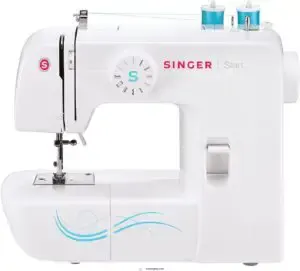
At the entry point of quilting machines, the Singer Start 1304 delivers impressive performance for its compact size.
You’ll find 57 stitch applications with pre-set dimensions that eliminate guesswork from your creative process.
Weighing just 7 pounds, it’s perfect for crafters with limited space or those who attend classes.
The automatic bobbin winding system stops when full, saving you from those "oops, it’s overfilled" moments.
With a free arm design for handling cylindrical items and an extensive accessory kit, this beginner-friendly machine comes backed by a reassuring 25-year warranty.
Best For: Beginners, hobbyists, and crafters needing a simple, portable sewing machine for small projects.
- Lightweight and portable for ease of transport and storage.
- Beginner-friendly with pre-set stitch settings and automatic features.
- Comes with a 25-year limited warranty for long-term reliability.
- Limited to basic stitching functions, not ideal for advanced sewers.
- Lacks advanced features like computerized controls.
- Small size may not handle large or heavy-duty projects effectively.
2. Juki HZL F600 Sewing Quilting Machine

Anyone looking for industrial-grade quilting power will find their match in the Juki HZL F600.
This workhorse combines 255 built-in stitches with a box feed system that handles everything from delicate fabrics to thick denim.
You’ll appreciate the user-friendly LCD screen and automatic needle threader when tackling lengthy projects.
The machine’s knee lifting lever keeps your hands free while managing fabric positioning.
With its precise 1/4" needle placement and two LED lights illuminating your workspace, the F600 delivers professional results.
It’s whisper-quiet operation is just icing on the quilting cake.
Best For: Experienced sewists and quilters who need a versatile, high-performance machine for intricate projects and heavy materials.
- 255 built-in stitches with industrial-grade stitch quality.
- User-friendly LCD screen and automatic needle threader for convenience.
- Quiet operation with two LED lights and precise needle placement.
- Higher price point compared to entry-level sewing machines.
- Slight learning curve for beginners due to advanced features.
- Large size may require dedicated storage or workspace.
3. Brother PQ1600S Sewing Quilting Machine
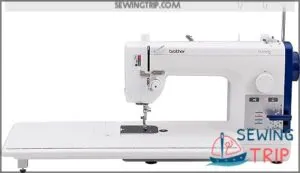
The powerhouse Brother PQ1600S offers serious quilters a dream machine that doesn’t waste time on frills.
With speeds up to 1,500 stitches per minute, you’ll finish projects in record time. The extra-large 11.1" x 23.3" workspace gives you plenty of room for those king-sized quilts you’ve been putting off.
You’ll appreciate thoughtful features like the automatic thread cutter, adjustable pin feed mechanism, and customizable needle stop position. Though it’s limited to straight stitches only, the four color-coded feed dog levels guarantee perfect fabric control for any quilting project.
Brother machines also offer free-motion capabilities for creative designs, providing quilters with the flexibility they need to express their artistic vision.
Best For: Serious quilters and sewing enthusiasts looking for a high-speed, heavy-duty machine with precise fabric control for large projects.
- High-speed stitching up to 1,500 stitches per minute for quick project completion.
- Extra-large workspace for managing large quilts with ease.
- Adjustable feed dogs and pin feed mechanism for excellent fabric handling and control.
- Limited to straight stitching, restricting versatility for other sewing tasks.
- No bobbin visibility or low thread warning, requiring frequent checks.
- Automatic threader can be challenging to use.
4. SINGER 9960 Sewing Quilting Machine
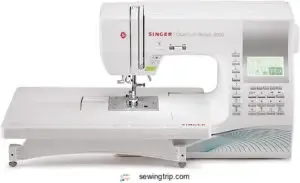
The SINGER 9960 offers a staggering 600 built-in stitches, making it a true creative playground for quilters.
You’ll appreciate the time-saving automatic needle threader and convenient top drop-in bobbin system.
The Needle Up/Down feature is a quilter’s best friend for precise pivoting around corners.
With its extension table and 13 presser feet (including a walking foot), you’re fully equipped for quilting adventures.
While some users note it’s not ideal for 1/4" seams, the adjustable speed control and thread trimmer button make up for minor shortcomings.
Best For: Quilters and sewing enthusiasts seeking a versatile machine with extensive stitch options and advanced customization features.
- 600 built-in stitches and 1,172 stitch applications for creative projects.
- Automatic needle threader and thread trimmer for time-saving convenience.
- Includes 13 presser feet and an extension table for quilting and large projects.
- Not ideal for 1/4" seams and lacks spacious harp area for large quilts.
- Overwhelming for beginners due to the complex feature set.
- Bobbin removal and compatibility issues with accessories.
5. Brother XR3774 Sewing and Quilting Machine
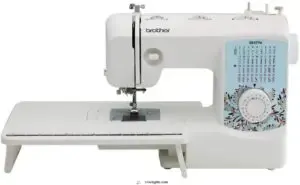
The Brother XR3774 is a versatile gem for quilting enthusiasts, blending ease of use with practical features.
Its 37 built-in stitches, including quilting and decorative options, let you express your creativity.
The wide table and free arm make handling large quilt projects a breeze, while the automatic needle threader saves time (and frustration).
Lightweight and beginner-friendly, it’s also robust enough for advanced users.
With its jam-resistant bobbin and included accessories, this machine guarantees smooth stitching, whether you’re crafting heirlooms or everyday pieces.
Best For: Beginners and advanced users looking for a reliable, versatile sewing and quilting machine that handles varied projects with ease.
- Includes 37 built-in stitches, wide table, and automatic needle threader for convenience.
- Jam-resistant top bobbin ensures smooth operation during sewing.
- Lightweight design ideal for portability yet durable for long-term use.
- Issues with skipped stitches and inconsistent performance across multiple units.
- Higher price compared to older, reliable models like Brother XL-2600i.
- Warranty voided if used outside the US due to 120-volt limitation.
6. Brother HC1850 Sewing Quilting Machine
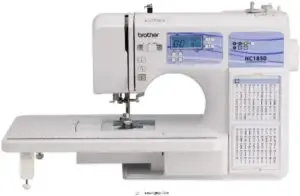
With its versatility and user-friendly design, the Brother HC1850 is like a trusty sidekick for quilters of all levels.
Boasting 185 built-in stitches, including 55 alphanumeric options, it’s perfect for decorative projects and monogramming.
The detachable wide table makes handling larger quilts a breeze, while the advanced needle threader saves time (and frustration).
Its adjustable sewing speed and quiet operation let you focus on creativity, not noise.
Lightweight yet sturdy, this machine balances portability with performance, offering exceptional value at just $190, making it a great choice due to its exceptional value.
Best For: Beginners and experienced sewers or quilters looking for a versatile, lightweight, and affordable sewing machine with advanced features.
- 185 built-in stitches, including decorative and alphanumeric options
- Lightweight design with a detachable wide table for larger projects
- Adjustable sewing speed and quiet operation for ease of use
- Needle threader can be difficult to use
- Dim work light may not be sufficient for detailed work
- Loose power cord connection can be inconvenient
7. Juki TL 2000Qi Sewing Quilting Machine
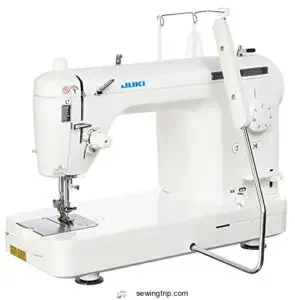
When precision and speed matter, the Juki TL 2000Qi delivers.
With a lightning-fast 1,500 stitches per minute, it’s perfect for tackling large quilts or intricate projects.
Its aluminum die-cast frame minimizes vibration, keeping your stitches smooth and consistent.
The included extension table expands your workspace, making bulky quilts manageable.
You’ll love the automatic needle threader—it’s a time-saver you didn’t know you needed!
Whether you’re a seasoned quilter or just diving in, this machine combines industrial power with user-friendly features.
Best For: Quilters and sewists who need high-speed, durable, and precise stitching for large or detailed projects.
- Lacks built-in decorative stitch options.
- Single-stitch function may be limiting for advanced garment projects.
- Larger size may require more storage space than compact machines.
- High-speed performance at 1,500 SPM for efficiency.
- User-friendly features like an automatic needle threader and LED lighting.
- Durable aluminum die-cast construction minimizes vibration.
8. Janome MC6650 Sewing Quilting Machine
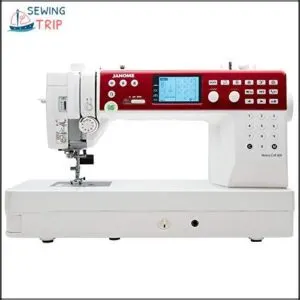
The Janome MC6650 is a quilting powerhouse that blends speed and precision seamlessly.
With 170 stitches, 2 alphabets, and a 10-inch all-metal flatbed, it’s perfect for tackling large projects.
You’ll love its automatic thread cutter, superior needle threader, and one-push needle plate conversion for effortless shifts.
The 1,000 stitches-per-minute speed keeps things moving, while the LED lighting guarantees clarity.
Its included accessories, like 12 presser feet and a universal sewing table, make quilting a breeze.
It’s reliable, versatile, and built for serious quilters.
Best For: Serious quilters and sewing enthusiasts looking for a high-speed, precision machine with versatile features.
- 170 built-in stitches, including decorative and utility options.
- Superior needle threader and automatic thread cutter for convenience.
- Large 10-inch all-metal flatbed for handling large quilting projects.
- Higher price point compared to basic sewing machines.
- Learning curve for beginners due to advanced features.
- Heavier design may limit portability.
9. Janome Magnolia 7318 Sewing Machine Bundle
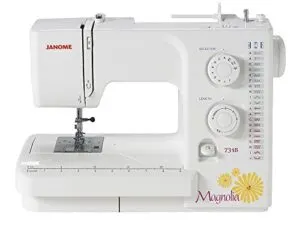
If you’re after reliability and simplicity, the Janome Magnolia 7318 is a solid pick.
With 18 built-in stitches, a top-loading bobbin system, and a 7-piece feed dog, it handles quilting projects with ease.
Its handy carrying handle and slide-out accessory tray make it portable and organized.
Though it’s not computerized, the manual controls are intuitive, making it great for beginners, and the included bundle—extra bobbins, needles, and quilting resources—sweetens the deal.
It’s a workhorse that won’t break the bank!
Best For: Beginners and intermediate sewists looking for a reliable, user-friendly machine for quilting, crafting, and home projects.
- Top-loading bobbin system prevents thread jams.
- Durable yet portable with a convenient carrying handle.
- Includes bonus accessories like bobbins and quilting tools.
- Not computerized, lacking advanced features like needle up/down positioning.
- Slightly noisier operation compared to similar models.
- Higher price point than some budget sewing machines.
10. Janome DC1050 Computerized Sewing Machine
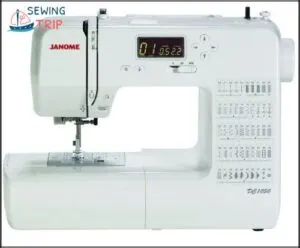
If you’ve ever wished for a sewing machine that feels like a trusty sidekick, the Janome DC1050 delivers.
With its computerized design, 50 built-in stitches, and a backlit LCD screen, it’s perfect for both beginners and pros.
The needle threader saves time, while the free arm handles tricky cylindrical projects.
Though lightweight, it’s packed with features like a speed control slider and locking stitch button.
Sure, the plastic parts may raise eyebrows, but its smooth operation and creative flexibility win hearts.
Best For: Beginners and professional sewers looking for an affordable, lightweight, and feature-rich sewing machine.
- 50 built-in stitches and easy-to-use backlit LCD screen.
- Automatic needle threader and free arm for versatile projects.
- Lightweight design with a speed control slider for customized sewing.
- Plastic components may affect durability over time.
- Limited speed control options and awkward bobbin insertion.
- Grinding sound during reverse sewing or auto lock stitch.
11. Janome 2212 Sewing Machine Bonus Bundle
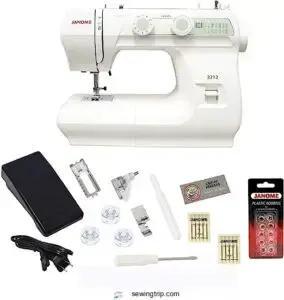
When you’re diving into quilting, the Janome 2212 Sewing Machine Bonus Bundle offers versatility without breaking the bank.
With 12 built-in stitches and a four-step buttonhole, it’s perfect for beginners and seasoned quilters alike.
The free arm makes sewing cuffs or sleeves a breeze, while the drop feed lets you experiment with free-motion quilting.
Lightweight at just 12 pounds, it’s easy to move around.
Plus, the bonus bundle—packed with bobbins, needles, and presser feet—adds incredible value to this user-friendly machine.
Best For: Beginners and experienced sewers looking for a versatile, portable, and user-friendly sewing machine for home projects.
- Lightweight and portable at 12 pounds.
- Includes 12 built-in stitches and a free arm for versatility.
- Comes with a bonus bundle of extras like bobbins, needles, and presser feet.
- Not suitable for industrial or heavy-duty sewing.
- Limited to 12 built-in stitches, which may not meet advanced needs.
- Requires regular maintenance such as oiling for optimal performance.
12. Brother XR9500PRW Sewing Machine Project Runway
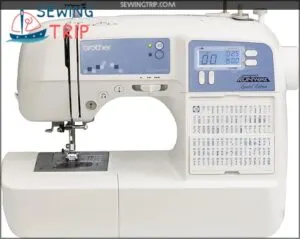
The Brother XR9500PRW is your creative sidekick, perfect for quilting and decorative projects.
With 100 built-in stitches, including heirloom and utility options, it’s versatile enough for most tasks.
The large back-lit LCD screen simplifies stitch selection, while the automatic needle threader and quick-set bobbin save time.
Its lightweight design makes it portable, yet it includes a wide table for handling larger projects.
Though it’s not ideal for heavy-duty fabrics, its affordability and user-friendly features make it a strong contender for beginners and hobbyists alike.
Best For: Beginners and hobbyists looking for an affordable, portable sewing machine with user-friendly features for quilting and decorative projects.
- 100 built-in stitches with utility, decorative, and heirloom options
- Automatic needle threader and quick-set bobbin for ease of use
- Lightweight design with a large back-lit LCD screen for clear stitch selection
- Not suitable for heavy-duty fabrics like thick denim
- Limited monogramming options with only one font and size
- Plastic case may feel less sturdy than higher-end models
13. Brother SE400 Sewing Embroidery Machine
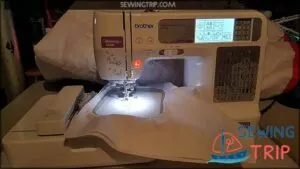
The SE400 combines sewing and embroidery, making it a versatile pick for creative projects.
With 70 built-in embroidery designs, 67 sewing stitches, and a 4"x4" embroidery area, it’s perfect for small to medium tasks.
The automatic needle threader saves time, while the backlit touchscreen simplifies stitch selection.
Beginners will love the guided threading and bobbin winding, though the limited hoop size might frustrate advanced users.
Need custom designs? External software is a must.
It’s compact, user-friendly, and ideal for multitasking makers.
Best For: Beginners and craft enthusiasts looking for a compact, user-friendly sewing and embroidery machine with dual functionality.
- Combines sewing and embroidery in one machine.
- Automatic needle threader and guided threading simplify setup.
- Compact, portable design ideal for small spaces.
- Limited 4"x4" hoop size restricts project scale.
- Requires external software for custom embroidery designs.
- Pre-loaded patterns are basic and occupy memory.
14. Brother CS6000i Sewing Quilting Machine
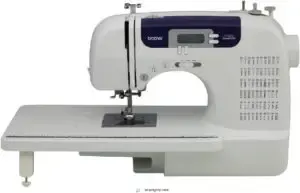
Balancing affordability with versatility, the Brother CS6000i is a gem for quilters.
With 60 built-in stitches, an automatic needle threader, and a jam-resistant drop-in bobbin, it’s perfect for beginners exploring their creativity.
The wide table offers room for quilting projects, while the LCD screen simplifies stitch selection.
Lightweight and portable, it’s great for crafting on the go, though it lacks an automatic thread cutter and struggles with heavy-duty fabrics.
Its user-friendly design and accessories make it a solid choice for hobbyists, providing a good balance between features and usability, making it a great option for those who value versatility.
Best For: Beginners and hobbyists looking for an affordable, versatile sewing machine for light to medium projects.
- 60 built-in stitches and wide table for versatility.
- Lightweight and portable, ideal for travel.
- User-friendly with an LCD screen and automatic needle threader.
- Not suitable for heavy-duty fabrics or frequent use.
- No automatic thread cutter included.
- Limited throat space for large quilting projects.
15. Brother PQ1500SL Sewing Quilting Machine
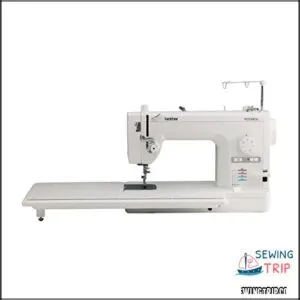
If speed is your game, the Brother PQ1500SL delivers with an impressive 1,500 stitches per minute.
This quilting powerhouse boasts an 8.6" throat space and a large extension table, perfect for tackling bulky quilts.
Its knee lifter and automatic thread cutter make handling fabric layers a breeze, while the jam-resistant drop-in bobbin keeps your workflow smooth.
Though it’s not beginner-friendly, its semi-industrial design and precision pin feed system guarantee professional-quality results.
For serious quilters, it’s a reliable, no-frills workhorse.
Best For: Experienced quilters and sewists seeking a high-speed, semi-industrial machine for precision and large projects.
- High-speed sewing with up to 1,500 stitches per minute.
- Large extension table and 8.6" throat space for handling quilts.
- Includes helpful features like knee lifter and automatic thread cutter.
- Not suitable for beginners due to advanced features and learning curve.
- Lacks decorative stitch options and zigzag functionality.
- LED light is dim and non-replaceable.
Budget Quilting Machines Under $900
You don’t need to break the bank to get a quilting machine that’s reliable and packed with features.
These budget-friendly options under $900 offer impressive stitch variety, sturdy performance, and just the right tools to bring your quilting projects to life.
Singer 8500Q
The Singer 8500Q quilting machine shines with its impressive 25-inch sewing space and quilting features that cater to large projects.
Its knee lifter offers hands-free fabric control, while the needle threader saves time.
With 215 built-in stitches, including quilting-specific options, this sewing machine delivers versatility.
You can find various quilting related products online.
Perfect for creative quilters, it’s a solid pick in quilting machine reviews under $900.
Husqvarna Viking Opal 650
The Husqvarna Viking Opal 650 stands out among quilting machines with its 8” sewing surface and computerized precision. Recognized as a "Best Buy," it balances advanced features with affordability, priced at $700.
With seamless stitch tie-offs and an Exclusive Sensor System, the Opal 650’s performance rivals pricier models. Many users seek Opal 650 quilting accessories to enhance their projects.
Maintenance is simple, making it a favorite in quilting machine reviews and comparisons, thanks to its advanced features.
Brother PC660LA Laura Ashley Sewing Machine
The Brother PC660LA quilting machine blends elegance and function, perfect for creative minds.
Its wide table width supports larger projects, while the LCD screen guarantees easy navigation. Enjoy free-motion quilting with its smooth operation and precise stitch variety. Plus, the machine speed keeps up with your ambition.
You can find Brother PC660LA products online.
- 138 stitch options
- Free-motion capabilities
- Back-lit LCD screen
- Wide table for quilting
Pfaff Passport 2.0
The Pfaff Passport 2.0 quilting machine is a gem for portability features, weighing just 13.9 lbs—perfect for classes or retreats.
Its integrated dual feed guarantees flawless quilting performance, even with tricky fabrics.
With 70 stitches, free-motion capabilities, and a built-in needle threader, it’s a compact powerhouse.
Ideal for tight spaces, it blends stitch variety with convenience effortlessly.
Juki HZL-F400
If the Pfaff Passport 2.0 impressed you with portability, the Juki HZL-F400 steps up with industrial-grade performance.
This quilting machine boasts a stellar Box-Feed system for smooth fabric handling, a reliable Tension System, and a Knee Lifter for hands-free control.
Add the automatic Thread Cutter and Free-Motion capabilities, and you’ve got a sewing machine built for precision and creativity.
Juki machines are known for industrial grade durability, ensuring longevity.
Advanced Quilting Machines for Professionals
If you’re ready to take your quilting to the next level, advanced machines offer unmatched precision and power for intricate designs and large projects.
With features like extended throat space, automatic thread cutters, and specialized stitch options, these models make tackling complex quilts both efficient and enjoyable.
Janome Horizon Memory Craft 8900QCP
The Janome Horizon Memory Craft 8900QCP is a powerhouse quilting machine built for professionals.
With its LCD touchscreen, memory function, and exceptional stitch quality, it handles large projects effortlessly.
The 11-inch arm space and extension table make quilting faster and smoother.
Its quilting speed and advanced features reveal endless creative potential, proving why it’s a top choice in quilting machine reviews.
Pfaff Quilt Expression 4.2
The Pfaff Quilt Expression 4.2 offers an extra-large surface perfect for ambitious projects.
Its Integrated Dual Feed guarantees flawless fabric control, while the quilting stitch options provide creative freedom.
With an automatic thread cutter and a responsive touchscreen interface, this quilting machine’s performance is exceptional.
It’s no wonder many consider it the best quilting machine for advanced crafters.
Brother Laura Ashley Innov-is NX-2000
Looking for a quilting machine with finesse? The Brother Laura Ashley Innov-is NX-2000 is a computerized sewing machine that blends Stitch Quality and Speed Control with a spacious Quilting Surface.
Its standout quilting machine features include:
- 460 built-in stitches for creative freedom
- Automatic Threading System for ease
- Durable build for long-term use
- 8.25” workspace for larger projects
- Automatic thread cutter for efficiency
Husqvarna Viking Sapphire 960Q
The Husqvarna Viking Sapphire 960Q combines a Sensor System and a vibrant touchscreen interface to deliver exceptional quilting performance.
With over 300 stitches, this quilting machine offers unmatched stitch variety for creative projects.
Its quilting machine features, like automatic thread cutting and precise tension control, enhance the user experience.
Perfect for pros seeking reliable quilting machine reviews and seamless craftsmanship.
BERNINA 770 Quilters Edition
Stepping up from the Sapphire 960Q, the BERNINA 770 Quilters Edition is a powerhouse for quilting enthusiasts.
Its Stitch Regulation guarantees precision in Free-Motion Quilting, while the high-speed sewing capability keeps you productive.
The specialized quilting foot enhances control, and the generous workspace is perfect for large projects.
This quilting machine balances advanced features with a seamless user experience, redefining quilting machine performance.
Bernina machines are known for guaranteeing consistent thread tension, guaranteeing consistent stitch quality.
Frequently Asked Questions (FAQs)
Which sewing machine is best for quilting?
You’ll want a quilting machine with a spacious throat, strong thread tension, and automatic features like thread cutters.
Models like the Juki HZL-F600 or Brother PQ1500SL balance power, precision, and ease for stunning quilts.
Which hybrid machine is best for sewing & quilting?
The Brother SE400 is a solid hybrid choice for sewing and quilting.
It combines 67 stitches, 70 embroidery designs, and computer connectivity, making it versatile for both creative quilting and everyday sewing projects.
Should you buy a sewing machine for quilting?
Did you know quilting machines can stitch up to 1,500 times a minute?
If you’re serious about quilting, investing in one streamlines projects, handles thick layers, and offers precision stitches you’ll love.
Is a quilting machine a sewing machine?
A quilting machine is a specialized type of sewing machine designed for handling thick layers of fabric and batting.
It offers features like larger throat space, stronger tension, and decorative stitch options perfect for quilting projects.
What is the best long arm sewing machine for quilting?
Ironically, mastering quilting’s art often starts with a machine.
For long-arm quilting, try the Handi Quilter Sweet
It’s fast, sturdy, and handles large projects beautifully, especially with suspension setups to manage quilt weight.
How much does a quilting machine cost?
Quilting machines range from $200 for basic models to $6,000+ for high-end options.
Prices depend on features like stitch variety, throat space, and automation.
Balance your needs, workspace, and budget to find the perfect fit.
What is the highest rated sewing machine?
The Brother CS7000X ranks as a top-rated sewing machine in 2025, blending versatility with ease of use.
Its 70 built-in stitches, automatic needle threader, and beginner-friendly design make it a standout choice.
Many users find that it offers a great balance of feature richness and affordability.
What is the most trouble-free sewing machine?
You’ll find the Janome HD1000 incredibly trouble-free, thanks to its heavy-duty build, automatic needle threader, and simple maintenance.
It’s like the reliable workhorse of sewing machines—strong, dependable, and easy to handle.
Which singer is best for quilting?
The Singer 8500Q is a solid pick for quilting.
With its 22” x 14” workspace, 215 stitches, knee lifter, and automatic needle threader, it’s designed to handle large projects while keeping things efficient.
What brands of longarm machines are there?
Did you know longarm quilting machines can handle quilts up to 18 feet wide?
Brands like Handi Quilter, Gammill, APQS, Innova, and Baby Lock offer powerful options for precision, speed, and creative freedom.
Conclusion
Funny how a “simple” search for the best quilting machine of 2017 can lead to 15 incredible options, each promising to elevate your craft.
Whether you crave industrial-grade power, computerized precision, or budget-friendly versatility, there’s a machine suited to your needs.
From the buttery-smooth Juki TL-2000Qi to the feature-packed Brother CS6000i, these models make quilting feel effortless.
Choose wisely, and your next project might just become your masterpiece—because quilting is more than a hobby; it’s an art.

